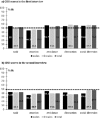Training to improve resilience and coping to monitor PTSD in rescue workers
- PMID: 31041412
- PMCID: PMC6477563
- DOI: 10.15167/2421-4248/jpmh2019.60.1.1134
Training to improve resilience and coping to monitor PTSD in rescue workers
Abstract
Background: Few studies focus on the role training has on rescue workers who are active as volunteers or actual workers in emergency situations such as an earthquake. In October 2016, a strong earthquake hit Central Italy and in particular the province of Macerata in the Marche region. Lots of rescuers were called to deal with the emergency. The aim of this study was, therefore, to examine their preparation, studying resilience and coping strategies, as these qualities can protect against complications brought on by traumatic situations (post traumatic stress disorder).
Study design: An observational study on 70 rescue workers who active in the area affected by the disaster within the province of Macerata was carried out.
Materials and methods: The questionnaire proposed by the Coping Inventory for Stressful situations (CISS) was used, while individual resilience levels were measured with the Resilience Scale. Both methods were employed in two separate interviews conducted before and after their intervention in the disaster area. To verify a possible difference between the resilience and coping values before and after the activity of rescue effort, the paired Student t test was applied.
Results: The sample showed medium to high levels of coping (91.6%) and resilience (89.6%) were present in both interviews and not significant statistical differences was observed for the resilience (among females t = 1.63, p-value = 0.179, and among males (t = -0.76; p-value = 0.487). In contrast, CISS scores before and after the rescue effort showed significant statistical differences both among females (t = 4.81; p-value = 0.009) and males (t = 10.06; p-value = 0.001).Some areas relative to coping mechanisms, such as social avoidance and distraction are preferred by women, while men prefer avoidance and task-oriented activity. Results for resilience show a slight difference for perseverance in men.
Conclusions: The ability to use mechanisms of self-preservation like coping and resilience helps rescue workers to better respond in emergency situations. Surely one of the most appropriate ways to reach this result is provided by their preparation.
Keywords: Coping; Earthquake; Rescue; Resilience.
Figures



References
-
- WHO/HPR/HEP/98.1. Health Promotion Glossary. 1998. http://www.who.int/healthpromotion/about/HPR%20Glossary%201998.pdf
-
- Petrelli F, Contratti CM, Tanzi E, Grappasonni I. Vaccine hesitancy, a public health problem. Ann Ig 2018;30(2):86-103. doi: 10.7416/ai.2018.2200. - PubMed
-
- American Psychiatric Association. Diagnostic Criteria from DSMIV-TR. Washington, DC: 2000.
Publication types
MeSH terms
LinkOut - more resources
Full Text Sources
Medical
